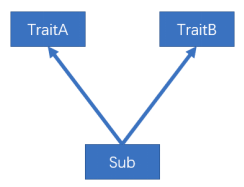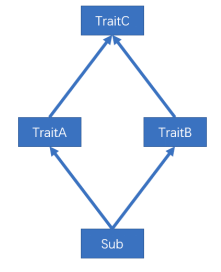简介
Scala语言中,采用特质trait(特征)来代替接口的概念,也就是说,多个类具有相同的特质(特征)时,就可以将这个特质(特征)独立出来,采用关键字trait声明
Scala中的trait中即可以有抽象属性和方法,也可以有具体的属性和方法,一个类可以混入(mixin)多个特质。这种感觉类似于Java中的抽象类
Scala引入trait特征,第一可以替代Java的接口,第二个也是对单继承机制的一种补充
特质声明
- 基本语法 ```scala trait 特质名 { trait主体 }
2. **案例实操**ps:通过查看字节码,可以看到 特质 = 抽象类 + 接口```scalatrait PersonTrait {// 声明属性var name: String = _// 声明方法def eat(): Unit = {}// 抽象属性var age: Int// 抽象方法def say(): Unit}
特质基本语法
一个类具有某种特质(特征),就意味着这个类满足了这个特质(特征)的所有要素,所以在使用时,也采用了extends关键字,如果有多个特质或存在父类,么需要采用with关键字连接
- 基本语法 ```scala 没有父类: class 类名 extends 特质1 with 特质2 with 特质3 … 有父类: class 类名 extends 父类 with 特质1 with 特质2 with 特质3…
2. **说明**(1)类和特质的关系:使用继承的关系。<br />(2)当一个类去继承特质时,第一个连接词是extends,后面是with。<br />(3)如果一个类在同时继承特质和父类时,应当把父类写在extends后3. **案例实操**(1)特质可以同时拥有抽象方法和具体方法```scalatrait PersonTrait {//声明属性var name: String = _//抽象属性var age: Int//声明方法def eat(): Unit = {println("eat")}//抽象方法def say(): Unit}
(2)一个类可以混入(mixin)多个特质
(3)所有的Java接口都可以当做Scala特质使用
class Teacher extends PersonTrait with java.io.Serializable {override def say(): Unit = {println("say")}override var age: Int = _}
(4)动态混入:可灵活的扩展类的功能,创建对象时混入trait,而无需使类混入该trait,如果混入的trait中有未实现的方法,则需要实现
object TestTrait {def main(args: Array[String]): Unit = {val teacher = new Teacherteacher.say()teacher.eat()val t2 = new Teacher with SexTrait {override var sex: String = "男"}//调用混入trait的属性println(t2.sex)}}
没有冲突的叠加
如果没有接口叠加顺序的话, 就是从右到左
object HelloWorld {def main(args: Array[String]): Unit = {val student1 = new Student13()student1.increase()}}trait Knowledge15 {var amount: Int = 0def increase(): Unit = {println("knowledge increased")}}trait Talent15 {def increase(): Unit = {println("talent increased")}}// 定义一个父类class Person13 {val name: String = "person"var age: Int = 18def sayHello(): Unit = {println("hello from: " + name)}def increase(): Unit = {println("person increase")}}class Student13 extends Person13 with Talent15 with Knowledge15 {// 重写冲突的属性override val name: String = "student"override def increase(): Unit = {super.increase()}}
特质叠加
1.说明
由于一个类可以混入(mixin)多个trait,且trait中可以有具体的属性和方法,若混入的特质中具有相同的方法(方法名,参数列表,返回值均相同),必然会出现继承冲突问题。冲突分为以下两种:
(1)一个类(Sub)混入的两个trait(TraitA,TraitB)中具有相同的具体方法,且两个trait之间没有任何关系,解决这类冲突问题,直接在类(Sub)中重写冲突方法
(2)一个类(Sub)混入的两个trait(TraitA,TraitB)中具有相同的具体方法,且两个trait继承自相同的trait(TraitC),及所谓的“钻石问题”,解决这类冲突问题,Scala采用了 特质叠加 的策略
- 案例实操
所谓的特质叠加,就是将混入的多个trait中的冲突方法叠加起来
trait Ball {def describe(): String = {"ball"}}trait Color extends Ball {override def describe(): String = {"blue-" + super.describe()}}trait Category extends Ball {override def describe(): String = {"foot-" + super.describe()}}class MyBall extends Category with Color {override def describe(): String = {"my ball is a " + super.describe()}}object TestTrait {def main(args: Array[String]): Unit = {println(new MyBall().describe())}}
输出结果:my ball is a blue-foot-ball
特质叠加执行顺序
- 思考
上述案例中的super.describe()调用的是父trait中的方法吗?
当一个类混入多个特质的时候,scala会对所有的特质及其父特质按照一定的顺序进行排序,而此案例中的super.describe()调用的实际上是排好序后的下一个特质中的 describe() 方法,排序规则如下:
发现category继承ball, color也继承ball, 继承的一样, 先看extend是是谁? 谁就先列出来, 然后后面的那个接到上面前面
就是 color->category->ball
- 结论
(1)案例中的super,不是表示其父特质对象,而是表示上述叠加顺序中的下一个特质,即,MyClass中的super指代Color,Color中的super指代Category,Category中的super指代Ball
(2)如果想要调用某个指定的混入特质中的方法,可以增加约束:super[],例如 super[Category].describe()
特质自身类型
- 说明
自身类型可实现依赖注入的功能。 直接把这个类型的注入进来了
- 案例实操 ```scala class User(val name: String, val age: Int)
trait Dao { def insert(user: User) = { println(“insert into database :” + user.name) } }
trait APP { // 可以 abc: Dao => 也行 _: Dao =>
def login(user: User): Unit = { println(“login :” + user.name) insert(user) } }
object MyApp extends APP with Dao { def main(args: Array[String]): Unit = { login(new User(“bobo”, 11)) } }
```scalaclass User(val name: String, val password: String)trait UserDao {_: User =>// 向数据库插入数据def insert(): Unit = {// 可以用自身类型的属性, 但是要this.println(s"insert into db: ${this.name}")}}
特质的泛型
特征作为泛型类型和抽象方法非常有用
trait Iterator[A] {def hasNext: Booleandef next(): A}
扩展 trait Iterator [A] 需要一个类型 A 和实现方法hasNext和next。
使用 extends 关键字来扩展特征。然后使用 override 关键字来实现trait里面的任何抽象成员:
trait Iterator[A] {def hasNext: Booleandef next(): A}class IntIterator(to: Int) extends Iterator[Int] {private var current = 0override def hasNext: Boolean = current < tooverride def next(): Int = {if (hasNext) {val t = currentcurrent += 1t} else 0}}val iterator = new IntIterator(10)iterator.next() // returns 0iterator.next() // returns 1
和java一样,所有需要用到Traits的地方都可以用他的子类型代替。
import scala.collection.mutable.ArrayBuffertrait Pet {val name: String}class Cat(val name: String) extends Petclass Dog(val name: String) extends Petval dog = new Dog("Harry")val cat = new Cat("Sally")val animals = ArrayBuffer.empty[Pet]animals.append(dog)animals.append(cat)animals.foreach(pet => println(pet.name)) // Prints Harry Sally
这里animals需要的是Pet类型,我们可以用dog和cat代替
特质和抽象类的区别
(1)优先使用特质。一个类扩展多个特质是很方便的,但却只能扩展一个抽象类
(2)如果你需要构造函数参数,使用抽象类。因为抽象类可以定义带参数的构造函数,而特质不行(有无参构造)

